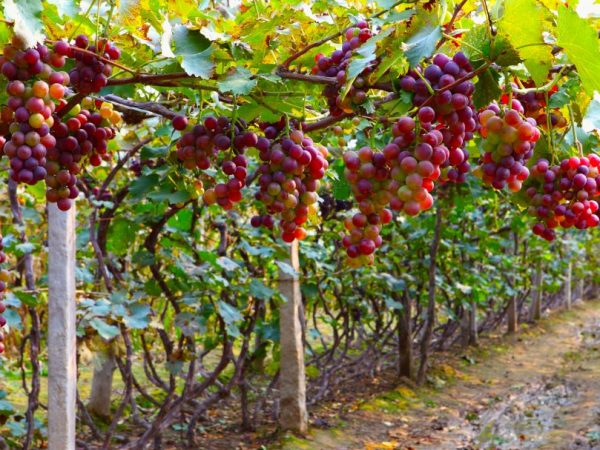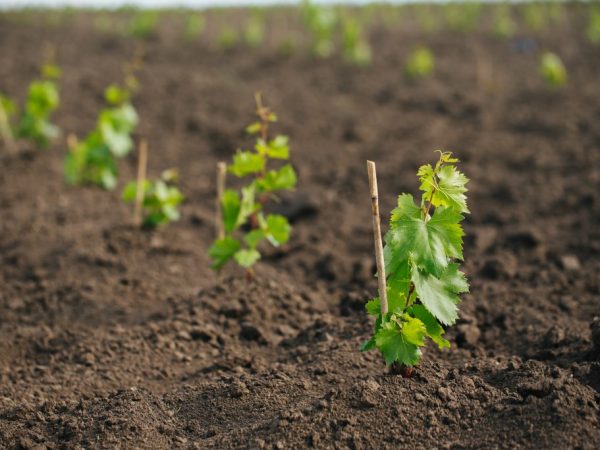Description of grapes Dozen
The Dozen grapes have been known to winegrowers since 2007. Consumers are attracted by the taste and aroma of fruits, and winegrowers are attracted by the plant's unpretentiousness to weather conditions and resistance to the most common pests and diseases.

Description of grapes Dozen
Characteristics of the variety
The Dozen grapes are table varieties. The progenitors of this hybrid are Red Rapture and Rizamat.
Description of the plant:
- Early ripeness. From the beginning of the growing season to harvesting, it takes about 125 days.
- Frost resistance. The plant does not need shelter for the winter, it can withstand up to - 27 ° C.
- Disease resistance. The plant needs 2 insecticide treatments per season.
- Vigorous growth. The growth of the vine exceeds 140 cm per year.
- Most of the buds on the vine are female.
- Blooms in early June.
- Large-fruited.
- Productivity. Five full-fledged brushes ripen on one lash.
- Keeping quality. The crop is stored without loss of taste for 60 days.
Description of fruits
- spherical shape;
- color is dark pink;
- firm pulp:
- sweet taste with a light hint of fruit;
- the skin is firm, but not felt when eaten;
- berry size up to 3 cm in diameter;
- weight - 20 gr.
According to the description, the bunches of the Dozen grapes have a conical shape. The maximum weight reaches 1500 g, while the average weight of a bunch is about 500 g. Among the positive qualities are resistance to cracking with an excess of moisture, as well as unattractiveness for wasps.
Growing varieties
Growing Dozen grapes is not difficult.
The vine is placed in elevated and well-lit areas with sod soil. The acidity of the soil does not play a role, but it is desirable to saturate the mineral composition of the earth:
- nitrogen;
- iron;
- potassium;
- calcium;
- magnesium;
- phosphorus.
Landing in the soil

The seedling needs to be tied to a peg
The soil for planting vines is prepared in the fall. The size of the recess should be at least 60 cm in width and length and 50 cm in depth.
The hole at the proposed landing site is filled with gravel or crushed stone, forming drains. After that, a layer of earth is poured and the mixture:
- 3 parts of humus;
- 1 piece of turf;
- 1 part river sand.
In conclusion, the pit is abundantly watered with settled or rainwater, to which 1 tbsp is added. l. nitroammophoska and potassium nitrate per 10 liters of water. The prepared ditch is covered with roofing material and left to winter.
In the spring, roofing material is removed and a vine is planted on which the bud opens. The planted plant is watered abundantly and provide protection from pests. A peg is driven in next to the seedling and a vine is tied to it.
The root space is sown with green manure or mulch. This not only loosens the soil, but also nourishes it with minerals and at the same time protects the soil from drying out.
Plant care
Plants should be protected from:
- drafts;
- temperature drops;
- drying out the soil.
Care instructions:
- The first feeding is done 1 month after transplanting.To do this, use humate or nitrogen organic fertilizer. The second portion of fertilizer is applied when the buds bloom at the bottom of the vine. The plant is fed the third time at the time of the ripening of the berries.
- Watering once 2 weeks is carried out under normal temperature conditions, not higher than 35 ° C in the shade.
- Treatment for powdery mildew and other diseases of the vine. A young plant, near which there are no sources of spread of diseases, is treated once with the complex preparation Fitosporin.
- Vine formation. Do not leave more than 25 shoots and 35 buds on one plant. Failure to comply will lead to wear and tear of the plant.
- Liana needs props. The seedling gives the first ovary in the second year, but these brushes are removed. Otherwise, the plant will not form the proper growth.
Diseases and pests
Diseases
According to the description, the Dozen grape variety is resistant to the most common diseases:
- mildew;
- oidium;
- gray rot.
That is why the plant does not need multiple treatments. But this does not exclude spraying according to the schedule: in the spring before the vines start to bloom and in the fall after the vine drops the leaves. In the spring, it is treated with boric acid, and in the fall with a Bordeaux mixture. In years when spring is characterized by an abundance of cloudy days and rains, a week after spraying with boric acid, a Bordeaux mixture or Fitosporin solution is sprayed.
Pests
Dozen grapes are not susceptible to pests. But if nearby plants are affected, then this variety will have to be treated for prevention. Use systemic insecticides, as well as folk formulations, consisting of:
- mustard powder;
- bitter red pepper;
- infusion of wormwood.
Conclusion
The Dozen grape variety is a suitable variety for cultivation not only in the southern regions, but also in the middle lane. Vine productivity is high. The plant bears fruit annually. The berries are large, sweet and juicy, so they are used in winemaking. Also, jam is made from the fruit, juice is squeezed out and marshmallow is prepared. Grapes are consumed fresh, because the brushes after harvesting can be stored for a long time.


